Pimlico Plumbers Case: Distinguishing Employees from Contractors
VerifiedAdded on 2023/06/09
|11
|3078
|174
Essay
AI Summary
This essay provides a detailed analysis of the differences between a 'Contract of Service' (employer-employee relationship) and a 'Contract for Services' (client-contractor relationship), with specific reference to the Pimlico Plumbers Ltd v Smith [2018] UKSC 29 case. It discusses the rights and obligations of both employees and self-employed contractors, highlighting key aspects such as control, mutuality of obligation, and the right of substitution. The essay also examines other relevant cases, including Aslam and others v Uber BV and others [2018] ICR 453 EAT and Autoclenz Ltd v Belcher and others [2011], to illustrate how courts determine employment status. Furthermore, it contrasts the benefits and risks associated with each type of contract, such as holiday pay, pension schemes, and financial liability. The essay concludes by emphasizing the importance for companies to review their contracts with self-employed individuals to ensure compliance with employment law.

Running head: Law for Accounting and Finance
Law for Accounting and Finance
Law for Accounting and Finance
Paraphrase This Document
Need a fresh take? Get an instant paraphrase of this document with our AI Paraphraser
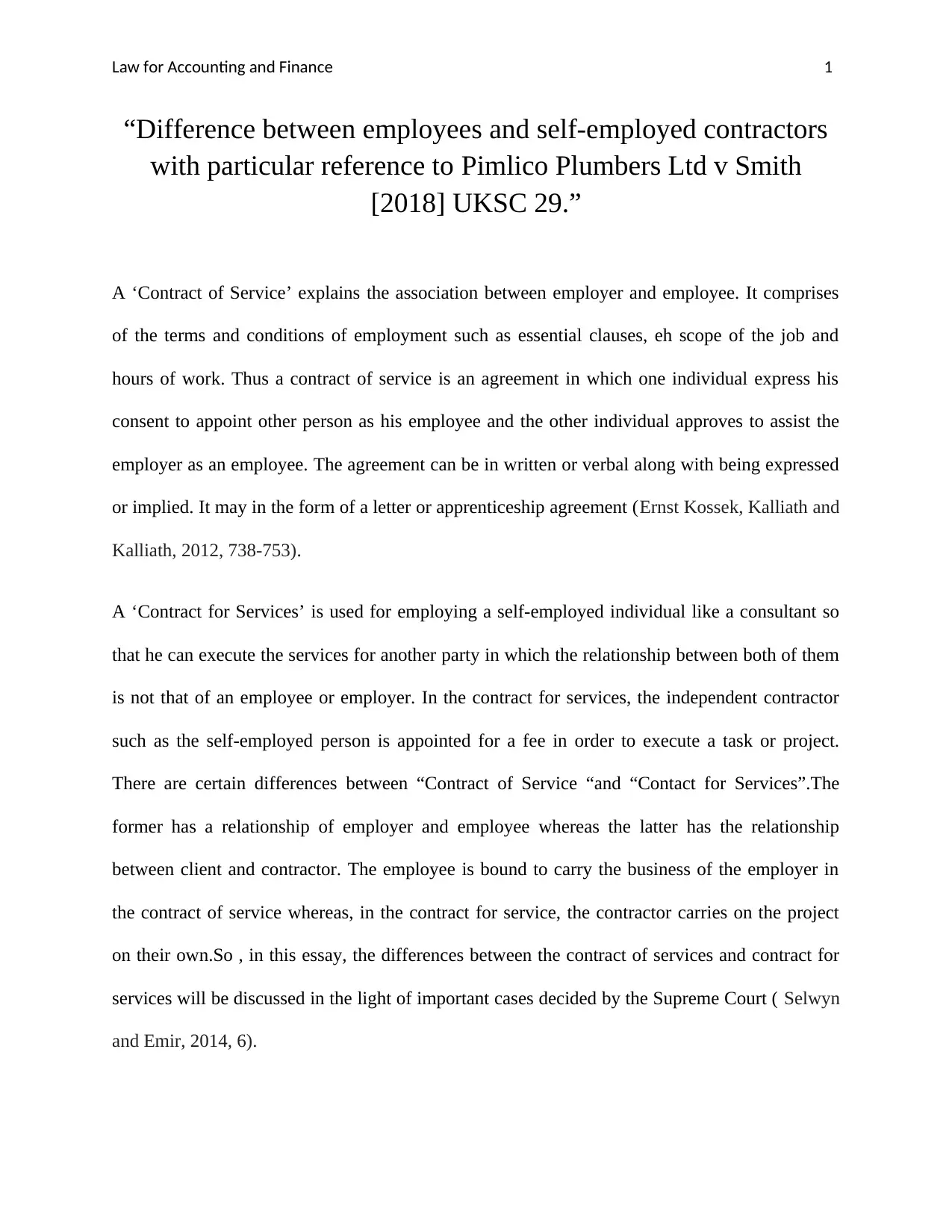
Law for Accounting and Finance 1
“Difference between employees and self-employed contractors
with particular reference to Pimlico Plumbers Ltd v Smith
[2018] UKSC 29.”
A ‘Contract of Service’ explains the association between employer and employee. It comprises
of the terms and conditions of employment such as essential clauses, eh scope of the job and
hours of work. Thus a contract of service is an agreement in which one individual express his
consent to appoint other person as his employee and the other individual approves to assist the
employer as an employee. The agreement can be in written or verbal along with being expressed
or implied. It may in the form of a letter or apprenticeship agreement (Ernst Kossek, Kalliath and
Kalliath, 2012, 738-753).
A ‘Contract for Services’ is used for employing a self-employed individual like a consultant so
that he can execute the services for another party in which the relationship between both of them
is not that of an employee or employer. In the contract for services, the independent contractor
such as the self-employed person is appointed for a fee in order to execute a task or project.
There are certain differences between “Contract of Service “and “Contact for Services”.The
former has a relationship of employer and employee whereas the latter has the relationship
between client and contractor. The employee is bound to carry the business of the employer in
the contract of service whereas, in the contract for service, the contractor carries on the project
on their own.So , in this essay, the differences between the contract of services and contract for
services will be discussed in the light of important cases decided by the Supreme Court ( Selwyn
and Emir, 2014, 6).
“Difference between employees and self-employed contractors
with particular reference to Pimlico Plumbers Ltd v Smith
[2018] UKSC 29.”
A ‘Contract of Service’ explains the association between employer and employee. It comprises
of the terms and conditions of employment such as essential clauses, eh scope of the job and
hours of work. Thus a contract of service is an agreement in which one individual express his
consent to appoint other person as his employee and the other individual approves to assist the
employer as an employee. The agreement can be in written or verbal along with being expressed
or implied. It may in the form of a letter or apprenticeship agreement (Ernst Kossek, Kalliath and
Kalliath, 2012, 738-753).
A ‘Contract for Services’ is used for employing a self-employed individual like a consultant so
that he can execute the services for another party in which the relationship between both of them
is not that of an employee or employer. In the contract for services, the independent contractor
such as the self-employed person is appointed for a fee in order to execute a task or project.
There are certain differences between “Contract of Service “and “Contact for Services”.The
former has a relationship of employer and employee whereas the latter has the relationship
between client and contractor. The employee is bound to carry the business of the employer in
the contract of service whereas, in the contract for service, the contractor carries on the project
on their own.So , in this essay, the differences between the contract of services and contract for
services will be discussed in the light of important cases decided by the Supreme Court ( Selwyn
and Emir, 2014, 6).
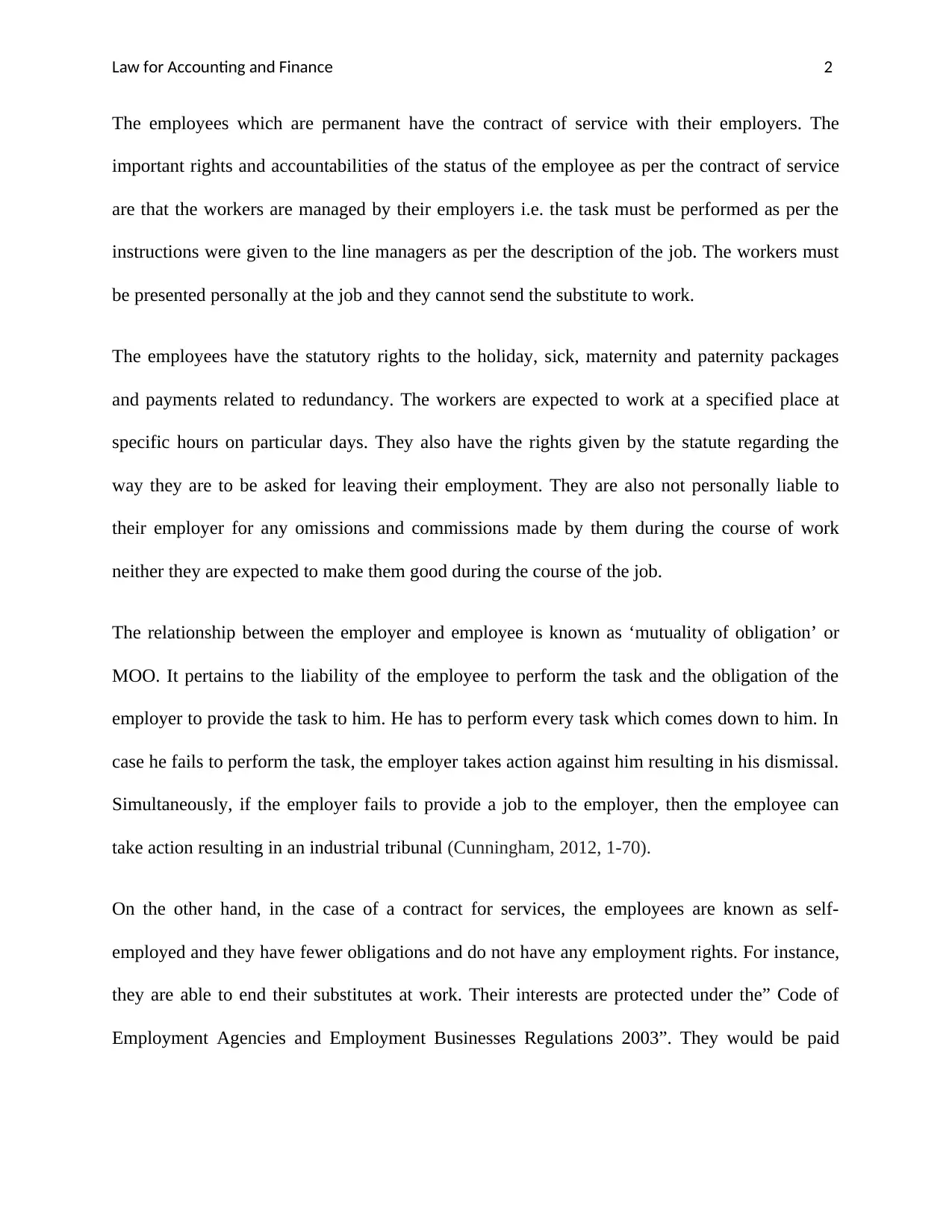
Law for Accounting and Finance 2
The employees which are permanent have the contract of service with their employers. The
important rights and accountabilities of the status of the employee as per the contract of service
are that the workers are managed by their employers i.e. the task must be performed as per the
instructions were given to the line managers as per the description of the job. The workers must
be presented personally at the job and they cannot send the substitute to work.
The employees have the statutory rights to the holiday, sick, maternity and paternity packages
and payments related to redundancy. The workers are expected to work at a specified place at
specific hours on particular days. They also have the rights given by the statute regarding the
way they are to be asked for leaving their employment. They are also not personally liable to
their employer for any omissions and commissions made by them during the course of work
neither they are expected to make them good during the course of the job.
The relationship between the employer and employee is known as ‘mutuality of obligation’ or
MOO. It pertains to the liability of the employee to perform the task and the obligation of the
employer to provide the task to him. He has to perform every task which comes down to him. In
case he fails to perform the task, the employer takes action against him resulting in his dismissal.
Simultaneously, if the employer fails to provide a job to the employer, then the employee can
take action resulting in an industrial tribunal (Cunningham, 2012, 1-70).
On the other hand, in the case of a contract for services, the employees are known as self-
employed and they have fewer obligations and do not have any employment rights. For instance,
they are able to end their substitutes at work. Their interests are protected under the” Code of
Employment Agencies and Employment Businesses Regulations 2003”. They would be paid
The employees which are permanent have the contract of service with their employers. The
important rights and accountabilities of the status of the employee as per the contract of service
are that the workers are managed by their employers i.e. the task must be performed as per the
instructions were given to the line managers as per the description of the job. The workers must
be presented personally at the job and they cannot send the substitute to work.
The employees have the statutory rights to the holiday, sick, maternity and paternity packages
and payments related to redundancy. The workers are expected to work at a specified place at
specific hours on particular days. They also have the rights given by the statute regarding the
way they are to be asked for leaving their employment. They are also not personally liable to
their employer for any omissions and commissions made by them during the course of work
neither they are expected to make them good during the course of the job.
The relationship between the employer and employee is known as ‘mutuality of obligation’ or
MOO. It pertains to the liability of the employee to perform the task and the obligation of the
employer to provide the task to him. He has to perform every task which comes down to him. In
case he fails to perform the task, the employer takes action against him resulting in his dismissal.
Simultaneously, if the employer fails to provide a job to the employer, then the employee can
take action resulting in an industrial tribunal (Cunningham, 2012, 1-70).
On the other hand, in the case of a contract for services, the employees are known as self-
employed and they have fewer obligations and do not have any employment rights. For instance,
they are able to end their substitutes at work. Their interests are protected under the” Code of
Employment Agencies and Employment Businesses Regulations 2003”. They would be paid
⊘ This is a preview!⊘
Do you want full access?
Subscribe today to unlock all pages.

Trusted by 1+ million students worldwide
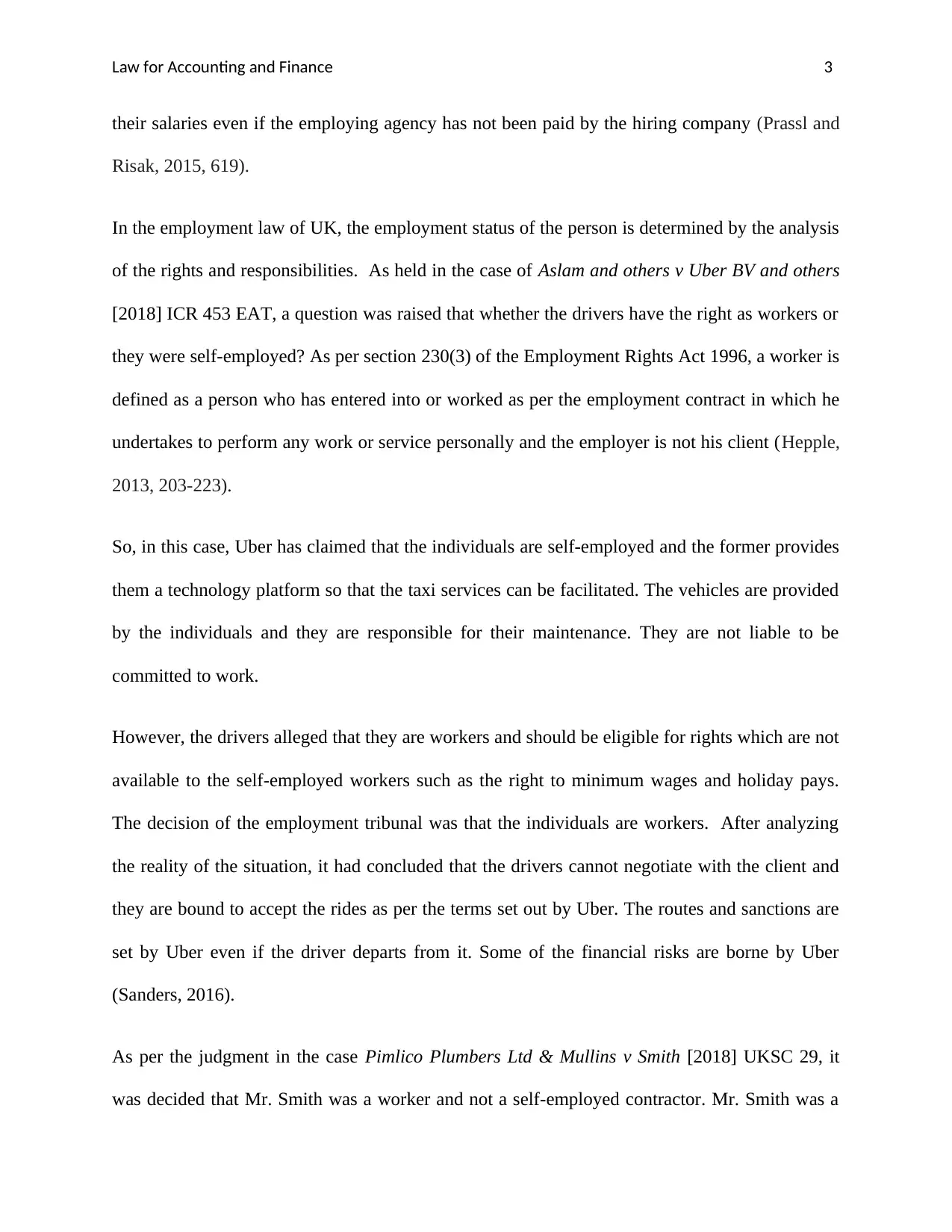
Law for Accounting and Finance 3
their salaries even if the employing agency has not been paid by the hiring company (Prassl and
Risak, 2015, 619).
In the employment law of UK, the employment status of the person is determined by the analysis
of the rights and responsibilities. As held in the case of Aslam and others v Uber BV and others
[2018] ICR 453 EAT, a question was raised that whether the drivers have the right as workers or
they were self-employed? As per section 230(3) of the Employment Rights Act 1996, a worker is
defined as a person who has entered into or worked as per the employment contract in which he
undertakes to perform any work or service personally and the employer is not his client (Hepple,
2013, 203-223).
So, in this case, Uber has claimed that the individuals are self-employed and the former provides
them a technology platform so that the taxi services can be facilitated. The vehicles are provided
by the individuals and they are responsible for their maintenance. They are not liable to be
committed to work.
However, the drivers alleged that they are workers and should be eligible for rights which are not
available to the self-employed workers such as the right to minimum wages and holiday pays.
The decision of the employment tribunal was that the individuals are workers. After analyzing
the reality of the situation, it had concluded that the drivers cannot negotiate with the client and
they are bound to accept the rides as per the terms set out by Uber. The routes and sanctions are
set by Uber even if the driver departs from it. Some of the financial risks are borne by Uber
(Sanders, 2016).
As per the judgment in the case Pimlico Plumbers Ltd & Mullins v Smith [2018] UKSC 29, it
was decided that Mr. Smith was a worker and not a self-employed contractor. Mr. Smith was a
their salaries even if the employing agency has not been paid by the hiring company (Prassl and
Risak, 2015, 619).
In the employment law of UK, the employment status of the person is determined by the analysis
of the rights and responsibilities. As held in the case of Aslam and others v Uber BV and others
[2018] ICR 453 EAT, a question was raised that whether the drivers have the right as workers or
they were self-employed? As per section 230(3) of the Employment Rights Act 1996, a worker is
defined as a person who has entered into or worked as per the employment contract in which he
undertakes to perform any work or service personally and the employer is not his client (Hepple,
2013, 203-223).
So, in this case, Uber has claimed that the individuals are self-employed and the former provides
them a technology platform so that the taxi services can be facilitated. The vehicles are provided
by the individuals and they are responsible for their maintenance. They are not liable to be
committed to work.
However, the drivers alleged that they are workers and should be eligible for rights which are not
available to the self-employed workers such as the right to minimum wages and holiday pays.
The decision of the employment tribunal was that the individuals are workers. After analyzing
the reality of the situation, it had concluded that the drivers cannot negotiate with the client and
they are bound to accept the rides as per the terms set out by Uber. The routes and sanctions are
set by Uber even if the driver departs from it. Some of the financial risks are borne by Uber
(Sanders, 2016).
As per the judgment in the case Pimlico Plumbers Ltd & Mullins v Smith [2018] UKSC 29, it
was decided that Mr. Smith was a worker and not a self-employed contractor. Mr. Smith was a
Paraphrase This Document
Need a fresh take? Get an instant paraphrase of this document with our AI Paraphraser
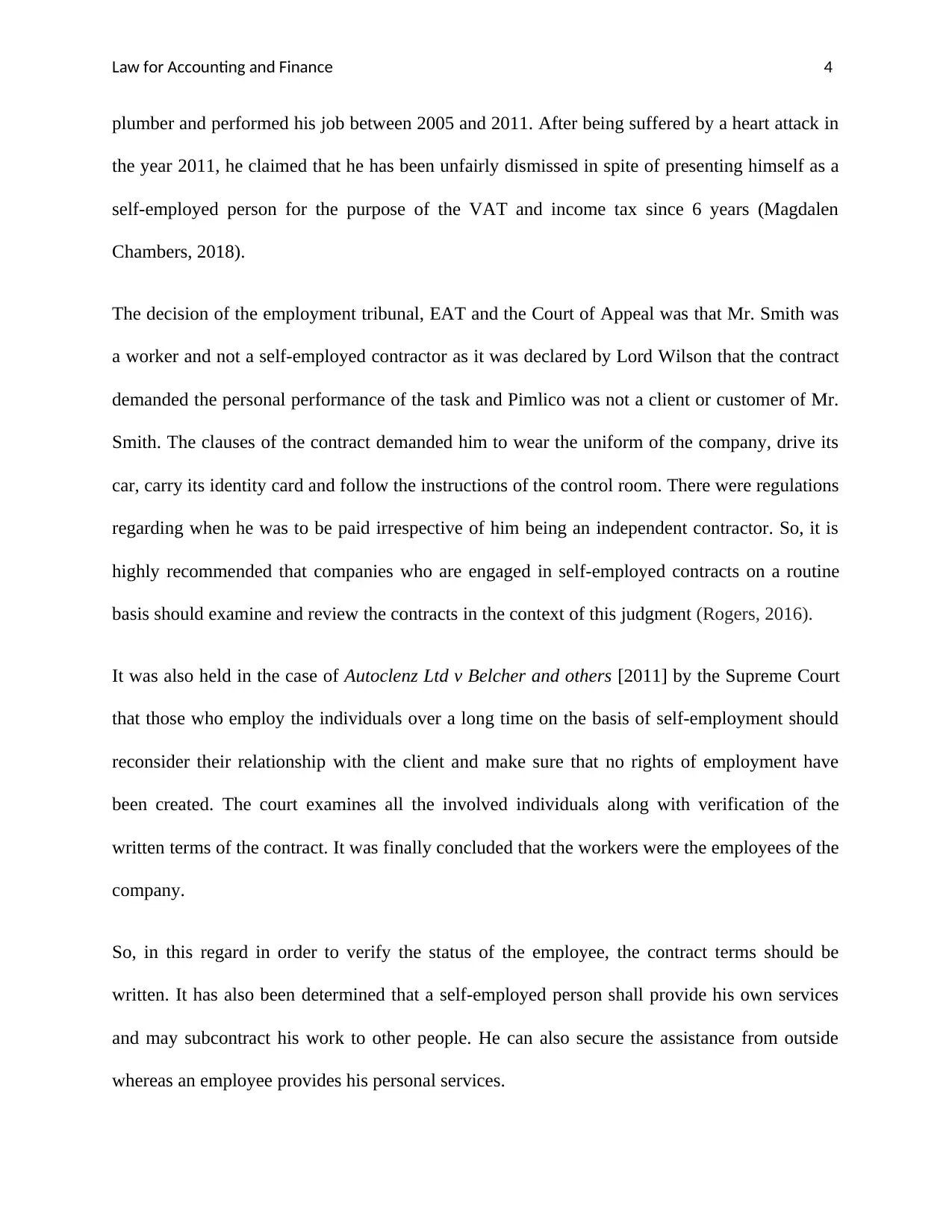
Law for Accounting and Finance 4
plumber and performed his job between 2005 and 2011. After being suffered by a heart attack in
the year 2011, he claimed that he has been unfairly dismissed in spite of presenting himself as a
self-employed person for the purpose of the VAT and income tax since 6 years (Magdalen
Chambers, 2018).
The decision of the employment tribunal, EAT and the Court of Appeal was that Mr. Smith was
a worker and not a self-employed contractor as it was declared by Lord Wilson that the contract
demanded the personal performance of the task and Pimlico was not a client or customer of Mr.
Smith. The clauses of the contract demanded him to wear the uniform of the company, drive its
car, carry its identity card and follow the instructions of the control room. There were regulations
regarding when he was to be paid irrespective of him being an independent contractor. So, it is
highly recommended that companies who are engaged in self-employed contracts on a routine
basis should examine and review the contracts in the context of this judgment (Rogers, 2016).
It was also held in the case of Autoclenz Ltd v Belcher and others [2011] by the Supreme Court
that those who employ the individuals over a long time on the basis of self-employment should
reconsider their relationship with the client and make sure that no rights of employment have
been created. The court examines all the involved individuals along with verification of the
written terms of the contract. It was finally concluded that the workers were the employees of the
company.
So, in this regard in order to verify the status of the employee, the contract terms should be
written. It has also been determined that a self-employed person shall provide his own services
and may subcontract his work to other people. He can also secure the assistance from outside
whereas an employee provides his personal services.
plumber and performed his job between 2005 and 2011. After being suffered by a heart attack in
the year 2011, he claimed that he has been unfairly dismissed in spite of presenting himself as a
self-employed person for the purpose of the VAT and income tax since 6 years (Magdalen
Chambers, 2018).
The decision of the employment tribunal, EAT and the Court of Appeal was that Mr. Smith was
a worker and not a self-employed contractor as it was declared by Lord Wilson that the contract
demanded the personal performance of the task and Pimlico was not a client or customer of Mr.
Smith. The clauses of the contract demanded him to wear the uniform of the company, drive its
car, carry its identity card and follow the instructions of the control room. There were regulations
regarding when he was to be paid irrespective of him being an independent contractor. So, it is
highly recommended that companies who are engaged in self-employed contracts on a routine
basis should examine and review the contracts in the context of this judgment (Rogers, 2016).
It was also held in the case of Autoclenz Ltd v Belcher and others [2011] by the Supreme Court
that those who employ the individuals over a long time on the basis of self-employment should
reconsider their relationship with the client and make sure that no rights of employment have
been created. The court examines all the involved individuals along with verification of the
written terms of the contract. It was finally concluded that the workers were the employees of the
company.
So, in this regard in order to verify the status of the employee, the contract terms should be
written. It has also been determined that a self-employed person shall provide his own services
and may subcontract his work to other people. He can also secure the assistance from outside
whereas an employee provides his personal services.
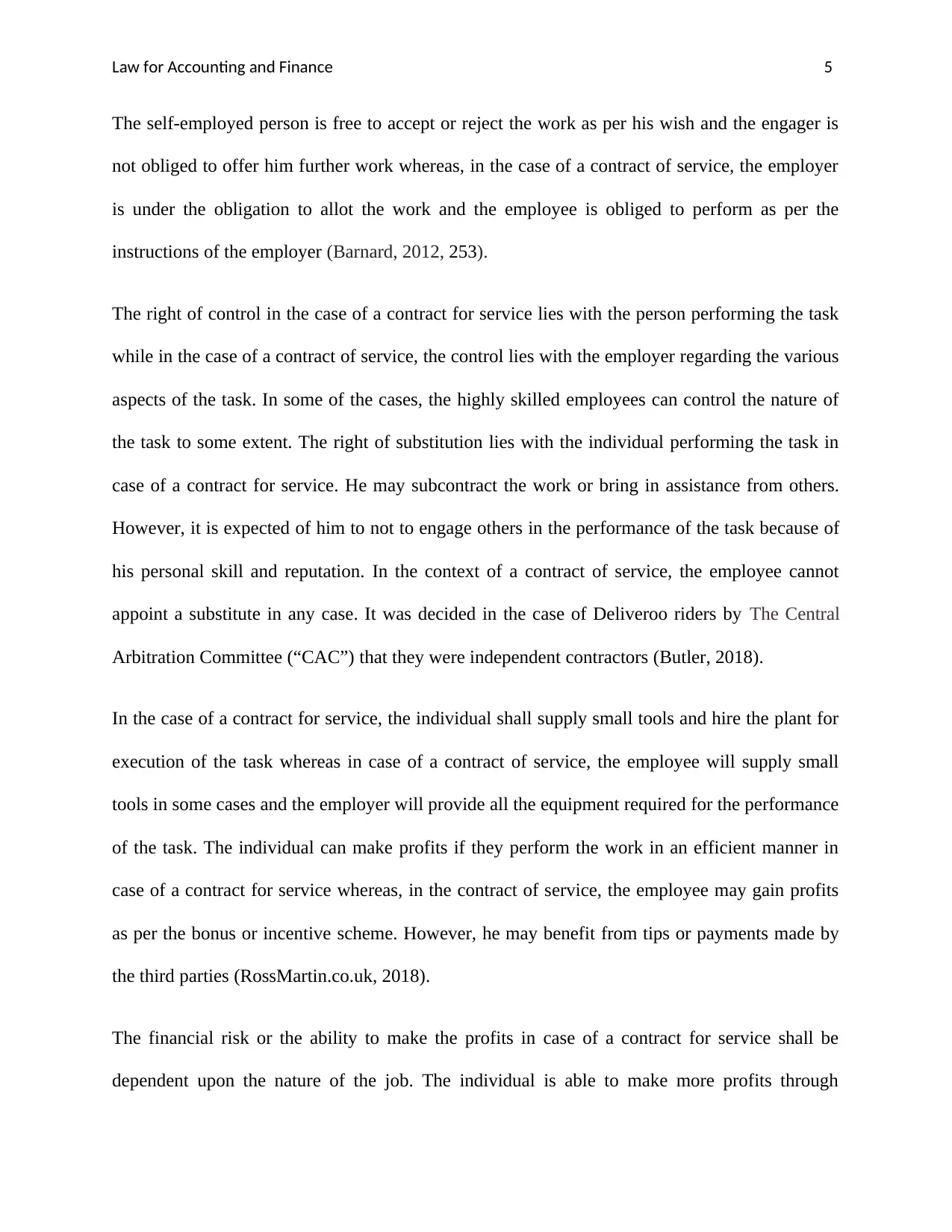
Law for Accounting and Finance 5
The self-employed person is free to accept or reject the work as per his wish and the engager is
not obliged to offer him further work whereas, in the case of a contract of service, the employer
is under the obligation to allot the work and the employee is obliged to perform as per the
instructions of the employer (Barnard, 2012, 253).
The right of control in the case of a contract for service lies with the person performing the task
while in the case of a contract of service, the control lies with the employer regarding the various
aspects of the task. In some of the cases, the highly skilled employees can control the nature of
the task to some extent. The right of substitution lies with the individual performing the task in
case of a contract for service. He may subcontract the work or bring in assistance from others.
However, it is expected of him to not to engage others in the performance of the task because of
his personal skill and reputation. In the context of a contract of service, the employee cannot
appoint a substitute in any case. It was decided in the case of Deliveroo riders by The Central
Arbitration Committee (“CAC”) that they were independent contractors (Butler, 2018).
In the case of a contract for service, the individual shall supply small tools and hire the plant for
execution of the task whereas in case of a contract of service, the employee will supply small
tools in some cases and the employer will provide all the equipment required for the performance
of the task. The individual can make profits if they perform the work in an efficient manner in
case of a contract for service whereas, in the contract of service, the employee may gain profits
as per the bonus or incentive scheme. However, he may benefit from tips or payments made by
the third parties (RossMartin.co.uk, 2018).
The financial risk or the ability to make the profits in case of a contract for service shall be
dependent upon the nature of the job. The individual is able to make more profits through
The self-employed person is free to accept or reject the work as per his wish and the engager is
not obliged to offer him further work whereas, in the case of a contract of service, the employer
is under the obligation to allot the work and the employee is obliged to perform as per the
instructions of the employer (Barnard, 2012, 253).
The right of control in the case of a contract for service lies with the person performing the task
while in the case of a contract of service, the control lies with the employer regarding the various
aspects of the task. In some of the cases, the highly skilled employees can control the nature of
the task to some extent. The right of substitution lies with the individual performing the task in
case of a contract for service. He may subcontract the work or bring in assistance from others.
However, it is expected of him to not to engage others in the performance of the task because of
his personal skill and reputation. In the context of a contract of service, the employee cannot
appoint a substitute in any case. It was decided in the case of Deliveroo riders by The Central
Arbitration Committee (“CAC”) that they were independent contractors (Butler, 2018).
In the case of a contract for service, the individual shall supply small tools and hire the plant for
execution of the task whereas in case of a contract of service, the employee will supply small
tools in some cases and the employer will provide all the equipment required for the performance
of the task. The individual can make profits if they perform the work in an efficient manner in
case of a contract for service whereas, in the contract of service, the employee may gain profits
as per the bonus or incentive scheme. However, he may benefit from tips or payments made by
the third parties (RossMartin.co.uk, 2018).
The financial risk or the ability to make the profits in case of a contract for service shall be
dependent upon the nature of the job. The individual is able to make more profits through
⊘ This is a preview!⊘
Do you want full access?
Subscribe today to unlock all pages.

Trusted by 1+ million students worldwide
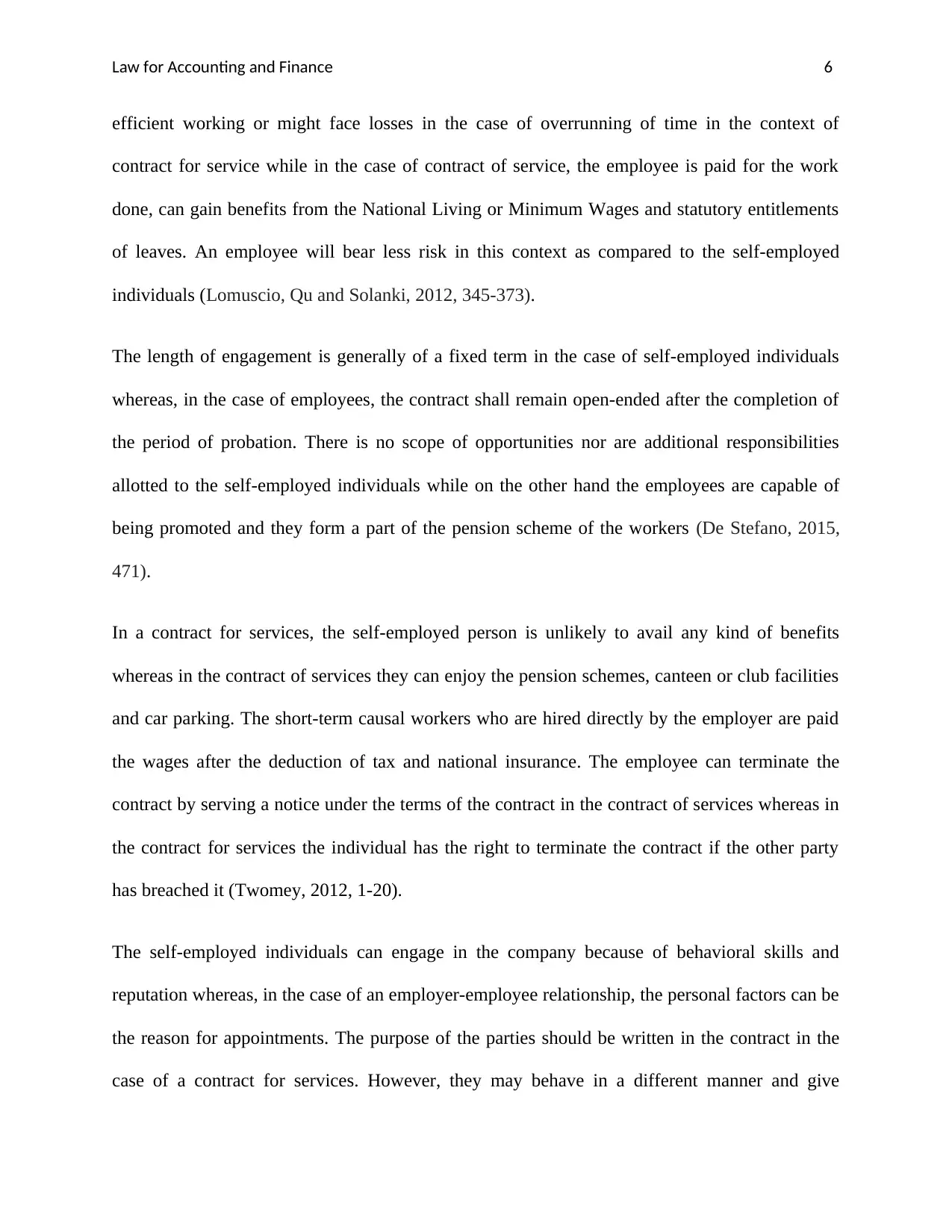
Law for Accounting and Finance 6
efficient working or might face losses in the case of overrunning of time in the context of
contract for service while in the case of contract of service, the employee is paid for the work
done, can gain benefits from the National Living or Minimum Wages and statutory entitlements
of leaves. An employee will bear less risk in this context as compared to the self-employed
individuals (Lomuscio, Qu and Solanki, 2012, 345-373).
The length of engagement is generally of a fixed term in the case of self-employed individuals
whereas, in the case of employees, the contract shall remain open-ended after the completion of
the period of probation. There is no scope of opportunities nor are additional responsibilities
allotted to the self-employed individuals while on the other hand the employees are capable of
being promoted and they form a part of the pension scheme of the workers (De Stefano, 2015,
471).
In a contract for services, the self-employed person is unlikely to avail any kind of benefits
whereas in the contract of services they can enjoy the pension schemes, canteen or club facilities
and car parking. The short-term causal workers who are hired directly by the employer are paid
the wages after the deduction of tax and national insurance. The employee can terminate the
contract by serving a notice under the terms of the contract in the contract of services whereas in
the contract for services the individual has the right to terminate the contract if the other party
has breached it (Twomey, 2012, 1-20).
The self-employed individuals can engage in the company because of behavioral skills and
reputation whereas, in the case of an employer-employee relationship, the personal factors can be
the reason for appointments. The purpose of the parties should be written in the contract in the
case of a contract for services. However, they may behave in a different manner and give
efficient working or might face losses in the case of overrunning of time in the context of
contract for service while in the case of contract of service, the employee is paid for the work
done, can gain benefits from the National Living or Minimum Wages and statutory entitlements
of leaves. An employee will bear less risk in this context as compared to the self-employed
individuals (Lomuscio, Qu and Solanki, 2012, 345-373).
The length of engagement is generally of a fixed term in the case of self-employed individuals
whereas, in the case of employees, the contract shall remain open-ended after the completion of
the period of probation. There is no scope of opportunities nor are additional responsibilities
allotted to the self-employed individuals while on the other hand the employees are capable of
being promoted and they form a part of the pension scheme of the workers (De Stefano, 2015,
471).
In a contract for services, the self-employed person is unlikely to avail any kind of benefits
whereas in the contract of services they can enjoy the pension schemes, canteen or club facilities
and car parking. The short-term causal workers who are hired directly by the employer are paid
the wages after the deduction of tax and national insurance. The employee can terminate the
contract by serving a notice under the terms of the contract in the contract of services whereas in
the contract for services the individual has the right to terminate the contract if the other party
has breached it (Twomey, 2012, 1-20).
The self-employed individuals can engage in the company because of behavioral skills and
reputation whereas, in the case of an employer-employee relationship, the personal factors can be
the reason for appointments. The purpose of the parties should be written in the contract in the
case of a contract for services. However, they may behave in a different manner and give
Paraphrase This Document
Need a fresh take? Get an instant paraphrase of this document with our AI Paraphraser
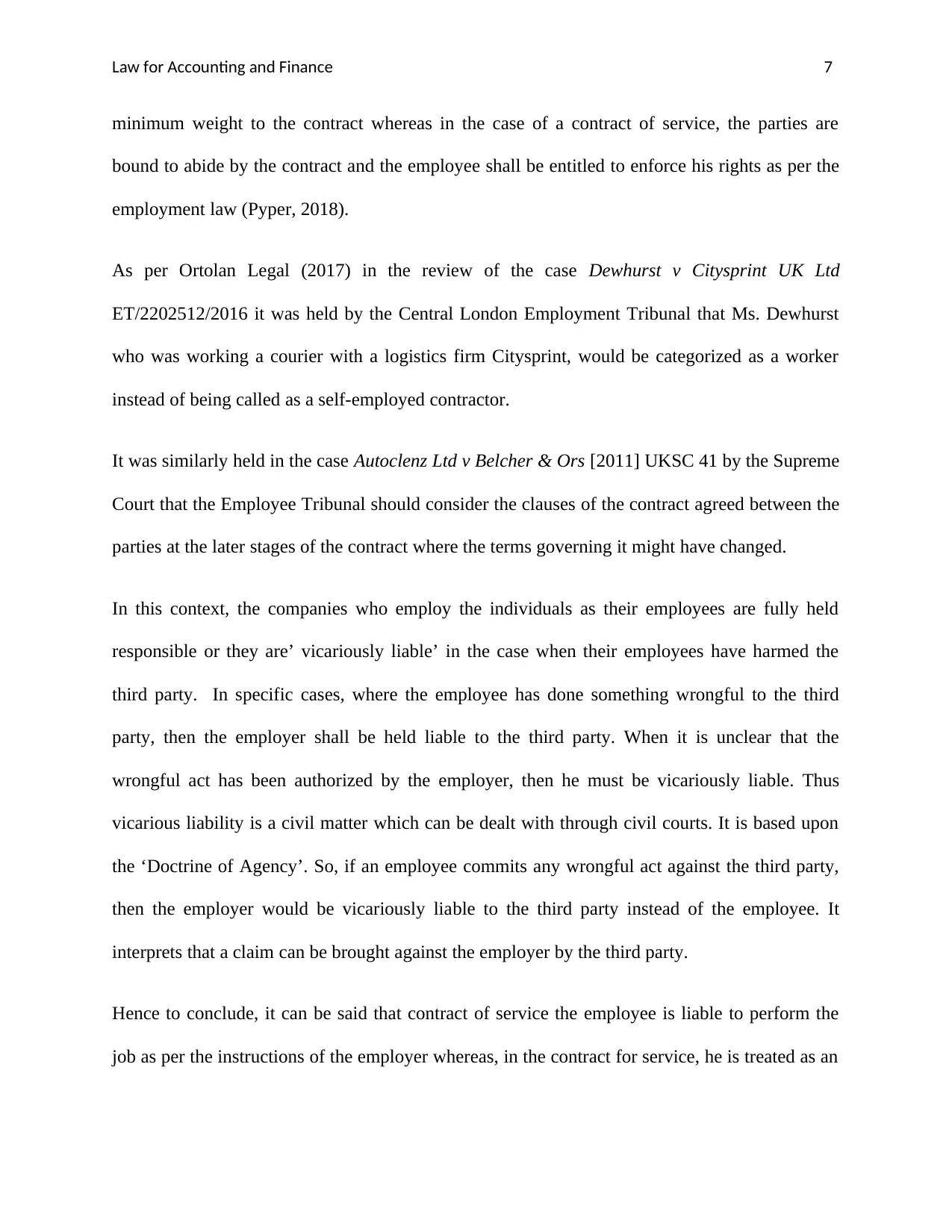
Law for Accounting and Finance 7
minimum weight to the contract whereas in the case of a contract of service, the parties are
bound to abide by the contract and the employee shall be entitled to enforce his rights as per the
employment law (Pyper, 2018).
As per Ortolan Legal (2017) in the review of the case Dewhurst v Citysprint UK Ltd
ET/2202512/2016 it was held by the Central London Employment Tribunal that Ms. Dewhurst
who was working a courier with a logistics firm Citysprint, would be categorized as a worker
instead of being called as a self-employed contractor.
It was similarly held in the case Autoclenz Ltd v Belcher & Ors [2011] UKSC 41 by the Supreme
Court that the Employee Tribunal should consider the clauses of the contract agreed between the
parties at the later stages of the contract where the terms governing it might have changed.
In this context, the companies who employ the individuals as their employees are fully held
responsible or they are’ vicariously liable’ in the case when their employees have harmed the
third party. In specific cases, where the employee has done something wrongful to the third
party, then the employer shall be held liable to the third party. When it is unclear that the
wrongful act has been authorized by the employer, then he must be vicariously liable. Thus
vicarious liability is a civil matter which can be dealt with through civil courts. It is based upon
the ‘Doctrine of Agency’. So, if an employee commits any wrongful act against the third party,
then the employer would be vicariously liable to the third party instead of the employee. It
interprets that a claim can be brought against the employer by the third party.
Hence to conclude, it can be said that contract of service the employee is liable to perform the
job as per the instructions of the employer whereas, in the contract for service, he is treated as an
minimum weight to the contract whereas in the case of a contract of service, the parties are
bound to abide by the contract and the employee shall be entitled to enforce his rights as per the
employment law (Pyper, 2018).
As per Ortolan Legal (2017) in the review of the case Dewhurst v Citysprint UK Ltd
ET/2202512/2016 it was held by the Central London Employment Tribunal that Ms. Dewhurst
who was working a courier with a logistics firm Citysprint, would be categorized as a worker
instead of being called as a self-employed contractor.
It was similarly held in the case Autoclenz Ltd v Belcher & Ors [2011] UKSC 41 by the Supreme
Court that the Employee Tribunal should consider the clauses of the contract agreed between the
parties at the later stages of the contract where the terms governing it might have changed.
In this context, the companies who employ the individuals as their employees are fully held
responsible or they are’ vicariously liable’ in the case when their employees have harmed the
third party. In specific cases, where the employee has done something wrongful to the third
party, then the employer shall be held liable to the third party. When it is unclear that the
wrongful act has been authorized by the employer, then he must be vicariously liable. Thus
vicarious liability is a civil matter which can be dealt with through civil courts. It is based upon
the ‘Doctrine of Agency’. So, if an employee commits any wrongful act against the third party,
then the employer would be vicariously liable to the third party instead of the employee. It
interprets that a claim can be brought against the employer by the third party.
Hence to conclude, it can be said that contract of service the employee is liable to perform the
job as per the instructions of the employer whereas, in the contract for service, he is treated as an

Law for Accounting and Finance 8
independent contractor. In the former, he is an integral part of the organization whereas in the
latter his work forms an accessory for it.
independent contractor. In the former, he is an integral part of the organization whereas in the
latter his work forms an accessory for it.
⊘ This is a preview!⊘
Do you want full access?
Subscribe today to unlock all pages.

Trusted by 1+ million students worldwide
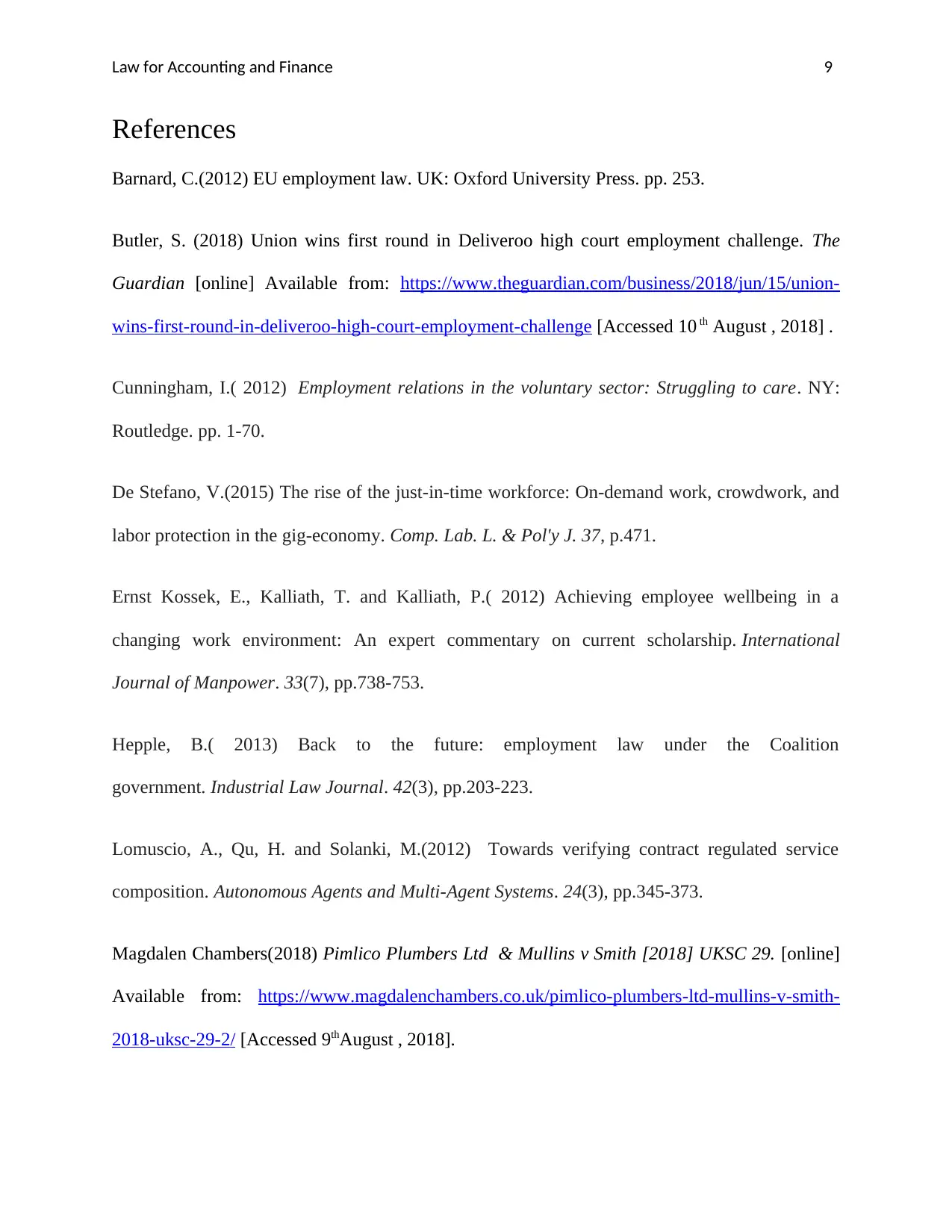
Law for Accounting and Finance 9
References
Barnard, C.(2012) EU employment law. UK: Oxford University Press. pp. 253.
Butler, S. (2018) Union wins first round in Deliveroo high court employment challenge. The
Guardian [online] Available from: https://www.theguardian.com/business/2018/jun/15/union-
wins-first-round-in-deliveroo-high-court-employment-challenge [Accessed 10 th August , 2018] .
Cunningham, I.( 2012) Employment relations in the voluntary sector: Struggling to care. NY:
Routledge. pp. 1-70.
De Stefano, V.(2015) The rise of the just-in-time workforce: On-demand work, crowdwork, and
labor protection in the gig-economy. Comp. Lab. L. & Pol'y J. 37, p.471.
Ernst Kossek, E., Kalliath, T. and Kalliath, P.( 2012) Achieving employee wellbeing in a
changing work environment: An expert commentary on current scholarship. International
Journal of Manpower. 33(7), pp.738-753.
Hepple, B.( 2013) Back to the future: employment law under the Coalition
government. Industrial Law Journal. 42(3), pp.203-223.
Lomuscio, A., Qu, H. and Solanki, M.(2012) Towards verifying contract regulated service
composition. Autonomous Agents and Multi-Agent Systems. 24(3), pp.345-373.
Magdalen Chambers(2018) Pimlico Plumbers Ltd & Mullins v Smith [2018] UKSC 29. [online]
Available from: https://www.magdalenchambers.co.uk/pimlico-plumbers-ltd-mullins-v-smith-
2018-uksc-29-2/ [Accessed 9thAugust , 2018].
References
Barnard, C.(2012) EU employment law. UK: Oxford University Press. pp. 253.
Butler, S. (2018) Union wins first round in Deliveroo high court employment challenge. The
Guardian [online] Available from: https://www.theguardian.com/business/2018/jun/15/union-
wins-first-round-in-deliveroo-high-court-employment-challenge [Accessed 10 th August , 2018] .
Cunningham, I.( 2012) Employment relations in the voluntary sector: Struggling to care. NY:
Routledge. pp. 1-70.
De Stefano, V.(2015) The rise of the just-in-time workforce: On-demand work, crowdwork, and
labor protection in the gig-economy. Comp. Lab. L. & Pol'y J. 37, p.471.
Ernst Kossek, E., Kalliath, T. and Kalliath, P.( 2012) Achieving employee wellbeing in a
changing work environment: An expert commentary on current scholarship. International
Journal of Manpower. 33(7), pp.738-753.
Hepple, B.( 2013) Back to the future: employment law under the Coalition
government. Industrial Law Journal. 42(3), pp.203-223.
Lomuscio, A., Qu, H. and Solanki, M.(2012) Towards verifying contract regulated service
composition. Autonomous Agents and Multi-Agent Systems. 24(3), pp.345-373.
Magdalen Chambers(2018) Pimlico Plumbers Ltd & Mullins v Smith [2018] UKSC 29. [online]
Available from: https://www.magdalenchambers.co.uk/pimlico-plumbers-ltd-mullins-v-smith-
2018-uksc-29-2/ [Accessed 9thAugust , 2018].
Paraphrase This Document
Need a fresh take? Get an instant paraphrase of this document with our AI Paraphraser
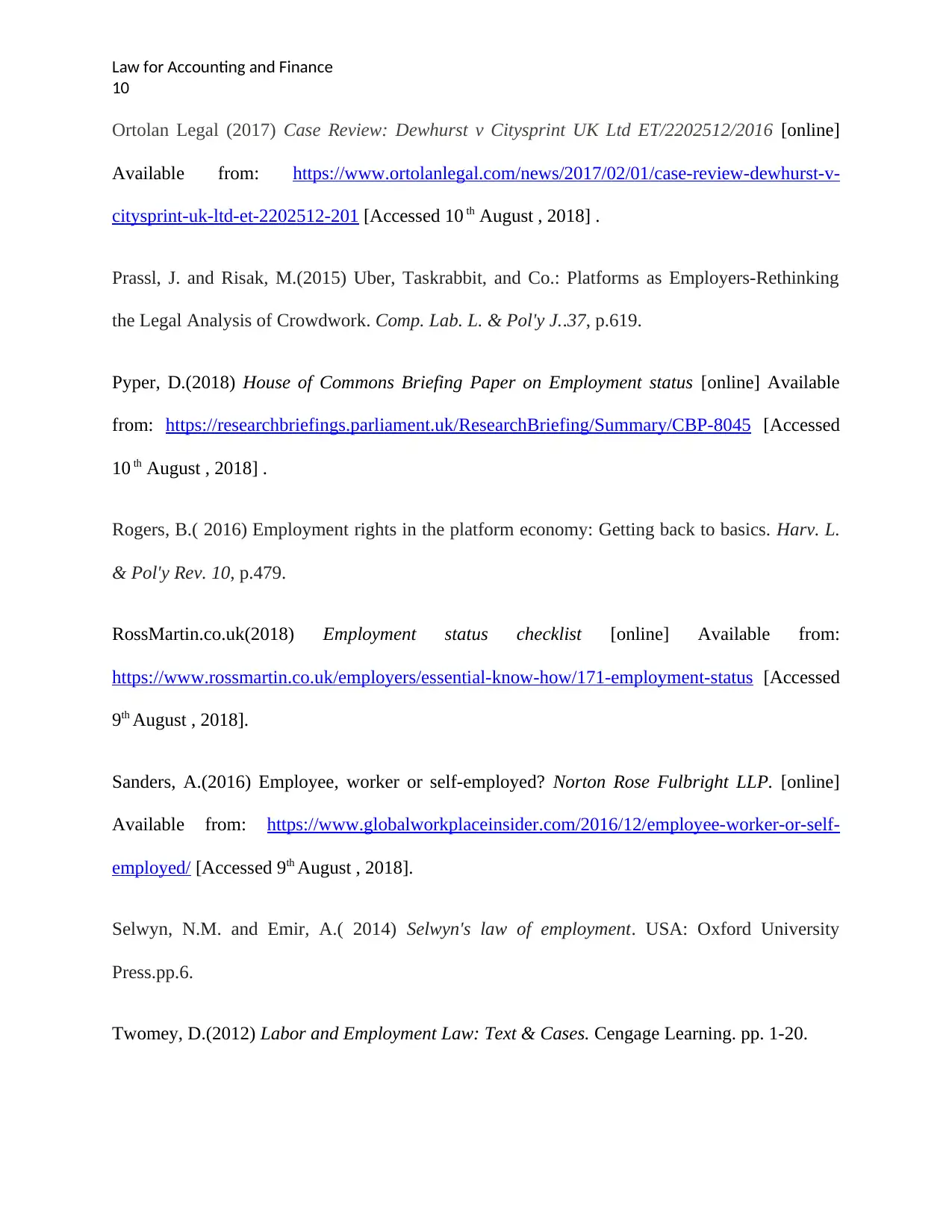
Law for Accounting and Finance
10
Ortolan Legal (2017) Case Review: Dewhurst v Citysprint UK Ltd ET/2202512/2016 [online]
Available from: https://www.ortolanlegal.com/news/2017/02/01/case-review-dewhurst-v-
citysprint-uk-ltd-et-2202512-201 [Accessed 10 th August , 2018] .
Prassl, J. and Risak, M.(2015) Uber, Taskrabbit, and Co.: Platforms as Employers-Rethinking
the Legal Analysis of Crowdwork. Comp. Lab. L. & Pol'y J..37, p.619.
Pyper, D.(2018) House of Commons Briefing Paper on Employment status [online] Available
from: https://researchbriefings.parliament.uk/ResearchBriefing/Summary/CBP-8045 [Accessed
10 th August , 2018] .
Rogers, B.( 2016) Employment rights in the platform economy: Getting back to basics. Harv. L.
& Pol'y Rev. 10, p.479.
RossMartin.co.uk(2018) Employment status checklist [online] Available from:
https://www.rossmartin.co.uk/employers/essential-know-how/171-employment-status [Accessed
9th August , 2018].
Sanders, A.(2016) Employee, worker or self-employed? Norton Rose Fulbright LLP. [online]
Available from: https://www.globalworkplaceinsider.com/2016/12/employee-worker-or-self-
employed/ [Accessed 9th August , 2018].
Selwyn, N.M. and Emir, A.( 2014) Selwyn's law of employment. USA: Oxford University
Press.pp.6.
Twomey, D.(2012) Labor and Employment Law: Text & Cases. Cengage Learning. pp. 1-20.
10
Ortolan Legal (2017) Case Review: Dewhurst v Citysprint UK Ltd ET/2202512/2016 [online]
Available from: https://www.ortolanlegal.com/news/2017/02/01/case-review-dewhurst-v-
citysprint-uk-ltd-et-2202512-201 [Accessed 10 th August , 2018] .
Prassl, J. and Risak, M.(2015) Uber, Taskrabbit, and Co.: Platforms as Employers-Rethinking
the Legal Analysis of Crowdwork. Comp. Lab. L. & Pol'y J..37, p.619.
Pyper, D.(2018) House of Commons Briefing Paper on Employment status [online] Available
from: https://researchbriefings.parliament.uk/ResearchBriefing/Summary/CBP-8045 [Accessed
10 th August , 2018] .
Rogers, B.( 2016) Employment rights in the platform economy: Getting back to basics. Harv. L.
& Pol'y Rev. 10, p.479.
RossMartin.co.uk(2018) Employment status checklist [online] Available from:
https://www.rossmartin.co.uk/employers/essential-know-how/171-employment-status [Accessed
9th August , 2018].
Sanders, A.(2016) Employee, worker or self-employed? Norton Rose Fulbright LLP. [online]
Available from: https://www.globalworkplaceinsider.com/2016/12/employee-worker-or-self-
employed/ [Accessed 9th August , 2018].
Selwyn, N.M. and Emir, A.( 2014) Selwyn's law of employment. USA: Oxford University
Press.pp.6.
Twomey, D.(2012) Labor and Employment Law: Text & Cases. Cengage Learning. pp. 1-20.
1 out of 11
Related Documents
Your All-in-One AI-Powered Toolkit for Academic Success.
+13062052269
info@desklib.com
Available 24*7 on WhatsApp / Email
![[object Object]](/_next/static/media/star-bottom.7253800d.svg)
Unlock your academic potential
Copyright © 2020–2025 A2Z Services. All Rights Reserved. Developed and managed by ZUCOL.





